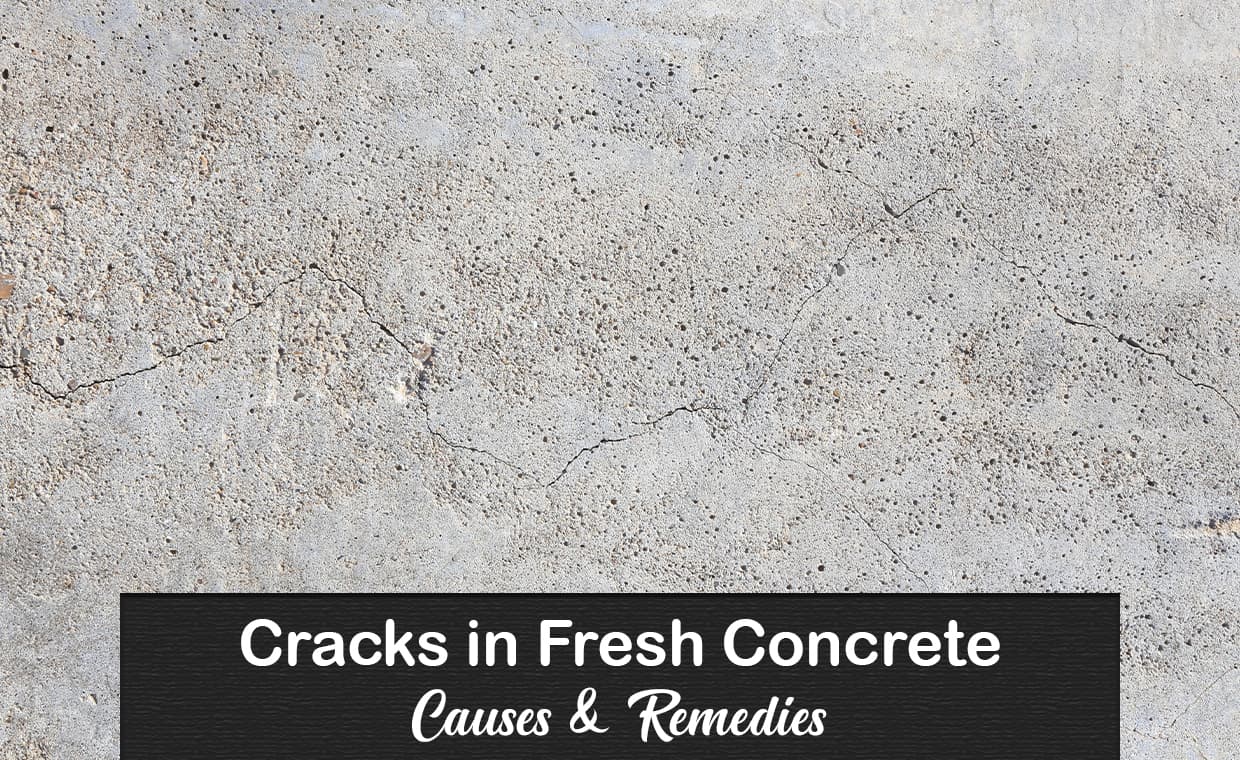
The concrete when fresh is known as plastic concrete. When this concrete is in plastic state, its components are fully mixed but still the concrete is incapable of providing strength. When the concrete is not completely stiffened, its volume may decrease due to the loss of water. Concrete thus available is said to be in plastic state.
Fresh concrete, also known as plastic concrete, is a freshly mixed material flexible enough which can be molded into any shape. The relative quantities of aggregates, cement and water are mixed together which controls the properties of concrete in the wet state as well as in the hardened state. Well, cracks can occur in any of these states. Here we are going to discuss about cracks in fresh concrete in the plastic state.
Like many of the construction materials, concrete is also influenced by the external temperature and moisture in the air and thus contracts and expands as per the changes in these factors. Its deflection depends upon the load and support conditions available at that given instance. When these aspects are not given a proper thought and provisions to accommodate such movements are not made in design, construction cracks are likely to occur.
Immediately after depositing the concrete, the solid particles tend to settle down due to gravity and the water rises at the top surface. This process is known as bleeding in concrete. Due to the bleeding process, a layer of water appears on the surface and this process continues till the concrete gets set.
Types of Cracks in Fresh Concrete (Plastic State)
Two types of cracks can occur in concrete in the plastic state which can be categorized as:
01. Plastic Shrinkage Cracks
02. Plastic Settlement Cracks
Now let us get more information regarding these two cracks.
01. Plastic Shrinkage Cracks
During construction, concrete cracks occur due to plastic shrinkage on the surface of the freshly laid concrete before it has set.
When the concrete surface loses water rapidly than the bleeding action, initial shrinkage of the top layer takes place. Since the concrete is still in the plastic state (not completely stiffened) and is not in a position to resist any tension, concrete cracks develop on the surface. If there is a continuous layer of water at the surface, then shrinkage does not occur.

Thus, plastic shrinkage cracks occur when fresh concrete is subjected to a very rapid loss of moisture while concrete is still in the plastic state. They are caused by a combination of several factors such as air and concrete temperature, relative humidity, and wind velocity at the surface of the concrete. These factors can cause high rate of evaporation in both the weather conditions – hot or cold.
Plastic shrinkage cracks are common in slabs. Because of rapid drying, the surface of concrete slab turns very stiff. Therefore, it cannot flow neither it can retain strength to withstand the tensile stresses caused by restrained shrinkage. This results in the development of cracks on the surfaces of slab.
Size & Shapes of Plastic Shrinkage Cracks
Plastic shrinkage cracks generally appear parallel to each other and are spaced between 0.3 m to 2m apart, up to 25 to 50mm deep or they can even pass through the entire slabs with thickness varying between 1mm to 2mm. The plastic shrinkage cracks often create a random pattern or a ‘map’ pattern.

The most notable feature of plastic shrinkage cracks is that they do not normally extend to the edge of the slab because it is free to shrink without restraint.
Plastic shrinkage concrete cracks should not be mistaken for ordinary drying shrinkage cracks. Ordinary drying shrinkage cracks occur only after a considerable time whereas Plastic shrinkage cracks can form just within the first 3 hours of casting although they are not often noticed until the following day. Plastic shrinkage cracks are not directly affected by the reinforcement in the concrete.
Precisely speaking, both plastic shrinkage cracks and plastic settlement cracks occur within a few minutes or few hours of concrete casting and finishing. They can appear anywhere between 10 minutes and 3 hours from the time of placing and finishing the concrete. These cracks develop when concrete is still in plastic state and has not completely hardened.
Causes of Cracks in Fresh Concrete

Concrete with undesirable physical and chemical properties is prone to plastic cracking. Most of the concrete structures develop cracks. Cracks cannot be eliminated completely but they can be restricted or minimized to a greater extent.
Fortunately, most of the cracking is on a microscopic scale and apparently does not appear as a fault. They generally do not affect the strength, stability and durability of the structure. But when cracking is macroscopic, it can result in loss of the strength, stability, and durability. It can also lessen sound insulation, affect overall efficiency and hamper the aesthetics of the structure to a greater extent.
The main causes of these types of cracks in slab of concrete in plastic state can be attributed to the following;
01. Water loss due to absorption by subgrade, formwork or aggregates
02. Bleeding and sedimentation
03. Poor workmanship and negligence
04. Flaws & errors in construction practices
05. Movement of concrete resulting from physical properties
06. Faulty or defective design
07. Weathering actions
08. Alkali-Aggregate reaction
09. Over troweling
The above factors can singly or collectively cause cracking in the concrete.
It can be summarized in brief as follows.

Plastic Shrinkage Cracks and Crazing in Slab
These are fine, shallow cracks caused by drying shrinkage of the surface when the concrete is still in plastic state i.e. before it hardens. Plastic shrinkage cracks emerge normally parallel while crazing cracks (also known as map cracking or checking) are intersecting. Crazing or hairline cracks are result of poor surface curing and they are visible only in hard troweled slabs. Both these cracks will have little impact on durability of concrete, if grouted immediately.
Diagonal Corner Cracks
Cracks at the corners of slabs are caused by curling (Curling is the distortion of a slab into a curved shape by upward or downward bending of the edges.) This is caused primarily due to the differences in moisture, temperature and/or moisture between the top and the bottom surfaces of a concrete slab.
How to Prevent it?
- By reducing water content in concrete, using optimum water-cement ratio
- By ensuring proper finishing of concrete Surface
- By proper curing of concrete
- Adequate vibration of concrete
- By proper compaction of concrete
Apart from diagonal corner cracks in concrete, Gharpedia has also authored an article on diagonal cracks in brick walls. You can get to know in detail from here.
According to “A. M. Neville”, the summary of Plastic shrinkage cracks in slab is as follows.

We are sure that after going through the above details, the concept of plastic shrinkage crack must be clear to our readers. So, let us now have a discussion regarding plastic shrinkage cracks.
02. Plastic Settlement Cracks
Plastic settlement cracks appear in freshly placed/laid cement concrete in reinforced structure. The plastic settlement cracks also crop up on the surface before concrete has set, when there is relatively high amount of bleeding. There is also some form of obstruction (i.e. reinforcement bars) to the downward sedimentation of the solids.

Fresh Concrete when placed in deep formwork such as wall or column, tend to settle or subside. If this settlement is curbed by the impediments like steel bars or large aggregates, it will lead to short horizontal cracks. Furthermore, these obstacles break the back of concrete above them by creating the voids under their belly. The subsidence due to reduction in volume is known as plastic settlement cracks.
Types of Plastic Settlement Cracks
When fresh concrete is placed in the formwork of column, wall etc., it has a tendency to settle or subside and if this settlement is detained due to hindrances like reinforcement bars or large aggregates, it causes plastic settlement cracks.
When settlement of the solids in concrete can happen freely and without restraint, there is a chance of decrease in the volume or depth of the actual concrete cast, but then no settlement cracks will develop.
Some typical plastic settlement cracks are described below.

Major Causes of Plastic Settlement Cracks are
- Reduction in the volume of the cement-water system due to segregation and bleeding.
- Internal confinement due to large size aggregate or reinforcement steel.
- External confinement due to comparatively narrow formwork.
- Pronounced change in concrete cross-section.
- Absorbent sub-base or formwork surface.
- Flared column heads, troughs and waffles in floor slabs.
- Settlement or bulging of formwork and supporting system.
The above factors can singly or collectively cause cracking in concrete.
Summary of Plastic Settlement Cracks in Concrete

Remedies for Plastic Shrinkage Cracks
Plastic shrinkage cracks normally appear in slab just after casting. However, these types of cracks are not harmful. But they can cause damage in the long run as it might allow water to pass through cracks causing leakage and corrosion. Hence, they should be filled by spreading cement slurry on the slab.
Conclusion
To sum up, how much aptness you try to maintain during construction, how much you try to follow in-detail every aspect of construction, yet it is not viable in fact, unrealistic to expect crack-free concrete construction. Crack in concrete is a never-ending issue and we shall always find cracks while dealing with concrete. There are different types of cracks and different causes for occurrence of cracks which we should take into consideration throughout while designing the concrete mix and concreting so as to prevent or reduce cracking. Engineers must have a thorough knowledge about the causes of cracking during the casting of concrete and avoid them to have the minimum cracking after construction and hardening.
Cracks are thus very common in every concrete structure. They are unavoidable, but they can be minimized by good design detailing, proper construction, procedures etc. Cracks in fresh concrete (Plastic Shrinkage) are not something to worry about but they must be controlled and repaired immediately, or else the durability of concrete structure will get affected in the long run.
If you want to expand your knowledge regarding cracks in concrete, then never forget to check blogs of Gharpedia on the same.
Horizontal Cracks in Walls of RCC Framed Structure
Types & Summary of Cracks in Reinforced Concrete Column
How to Repair Concrete Cracks in RCC Structure or House?


































